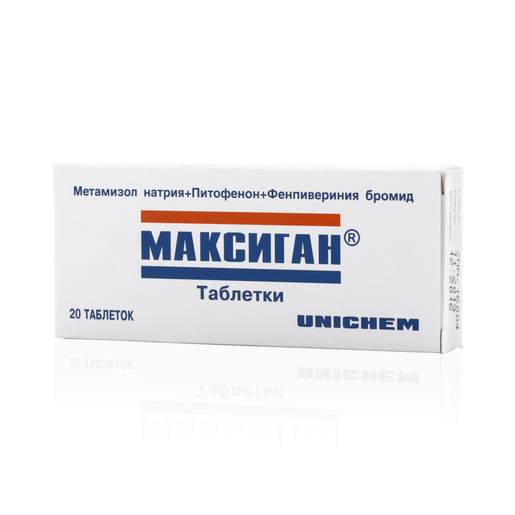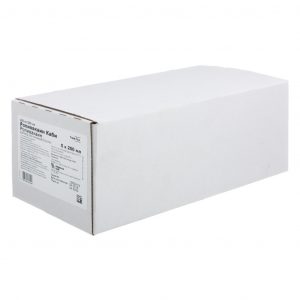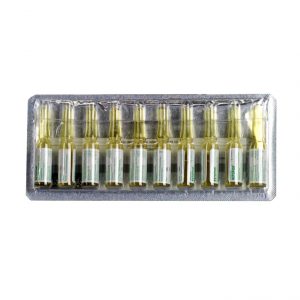Description
Release form
tablets
Packing
20 pcs.
Pharmacological action
Maxigan has an analgesic, anti-inflammatory, antispasmodic effect.
Indications
Mild or moderate pain with spasms of smooth muscles of the internal organs – renal and hepatic colic, spastic pain along the intestines, algomenorrhea. It can be used for short-term symptomatic treatment for joint pain, neuralgia, sciatica, myalgia.
As an adjuvant, it can be used to reduce pain after surgical and diagnostic procedures. If necessary, the drug can be used to reduce elevated body temperature in colds and infectious and inflammatory diseases.
Contraindications
Hypersensitivity to pyrazolone derivatives, and other components of the drug. Inhibition of bone marrow hematopoiesis, stable and unstable angina pectoris, chronic heart failure in the decompensation stage, liver and / or renal failure, glucose-6-phosphate dehydrogenase deficiency, tachyarrhythmias, angle-closure form of glaucoma, prostatic hyperplasia with a tendency to urinary retention, intestinal obstruction and megacolon, bronchial spasm, acute pain, acetylsalicylic acid, salicylates and other non-steroidal anti-inflammatory drugs, granulocytopenia, pregnancy, lact nation.
Maxigan ® in this dosage form is not recommended for use in children under 5 years of age.
With caution and under the supervision of a doctor, the drug should be used in patients with impaired liver or kidney function, with a tendency to hypotension (systolic pressure below 100 mmHg), bronchospasm. In case of impaired blood formation as a result of treatment with cytostatics.
If you have one of these diseases, be sure to consult your doctor before taking the drug.
Composition of
Each tablet contains: active ingredients: metamizole sodium – 500 mg,
pitophenone hydrochloride – 5 mg,
fenpiverinium bromide – 0.1 mg
excipients:
pregelatinized starch – 134.0 mg lactate, 25.0 mg 9 mg
silicon colloidal dioxide – 3.0 mg,
magnesium stearate – 6.0 mg,
talc – 6.0 mg.
Dosage and administration
Adults and children over 15 years of age are taken orally (preferably after meals), usually 1-2 tablets 2-3 times a day, without chewing, with a small amount of liquid. The daily dose should not exceed 6 tablets.
Duration of admission is not more than 5 days.
An increase in the daily dose of the drug or the duration of treatment is possible only on the recommendation and under the supervision of a doctor.
Dosages for children.
In children, the drug is used only as directed by a doctor.
Children 12-14 years old: single dose – 1 tablet, maximum daily dose – 6 tablets (1.5 tablets 4 times a day), 8-11 years old – 0.5 tablets, maximum daily dose – 4 tablets (1 tablet 4 times a day), 5-7 years – 0.5 tablets, the maximum daily dose – 2 tablets (0.5 tablets 4 times a day).
Side effects
Frequency. adverse reactions listed below determined according to the following (World Health Organization classification): very often – more than 1/10 often – from more than 1/100 to less than 1/10 infrequently – from more than 1/1000 to less than 1/100 rarely – from more than 1/10000 to less 1/1000 is very rare – from less than 1/10000, including individual messages.
Allergic reactions: urticaria, angioedema, in rare cases, malignant exudative erythema (Stevens-Johnson syndrome), toxic epidermal necrolysis (Lyell syndrome), bronchospastic syndrome, anaphylactic shock. From the urinary system: impaired renal function, oliguria, anuria, proteinuria, interstitial nephritis, urine staining in red.
From the cardiovascular system: lowering blood pressure.
From the side of hematopoietic organs: thrombocytopenia, leukopenia, agranulocytosis (may occur with the following symptoms: unmotivated fever, chills, sore throat, difficulty swallowing, stomatitis, as well as the development of vaginitis or proctitis).
Anticholinergic effects: dry mouth, decreased sweating, paresis of accommodation, tachycardia, difficulty urinating.
If any adverse adverse reactions occur, consult a doctor as soon as possible.
If any of the side effects indicated in the instructions are aggravated, or you notice any other side effects not listed in the instructions, inform your doctor.
Drug interaction
When co-administered with H1-histamine blockers, butyrophenones, phenothiazines, tricyclic antidepressants, Amantadine and quinidine may increase m-anticholinergic action.
Enhances the effects of ethanol: simultaneous use with chlorpromazine or other phenothiazine derivatives can lead to the development of severe hyperthermia.
Tricyclic antidepressants, oral contraceptives and allopurinol increase the toxicity of the drug.
Phenylbutazone, barbiturates, and other hepatoinductors, while administered, reduce the effectiveness of metamizole sodium. Sedative and anxiolytic drugs (tranquilizers) enhance the analgesic effect of metamizole sodium.
X-ray contrast drugs, colloidal blood substitutes, and penicillin should not be used during treatment with drugs containing metamizole sodium.
With the simultaneous administration of cyclosporine, the concentration of the latter in the blood decreases. Metamizole sodium displacing oral hypoglycemic drugs, indirect anticoagulants, corticosteroids and indomethacin from a protein bond, can increase the severity of their action. Tiamazole and cytostatics increase the risk of developing leukopenia.
The effect is enhanced by codeine, H2-histamine receptor blockers and propranolol (slows the inactivation of metamizole sodium).
Storage conditions
In the dark place, at a temperature not exceeding 25 ° C.
Conditions for dispensing from pharmacies
Without prescriptions words from drugstore
Without a prescription
lekarstvennaja tablet form
Unique Laboratories Ltd., India



